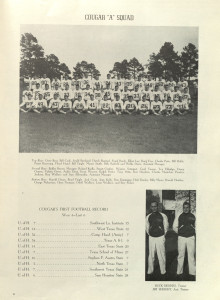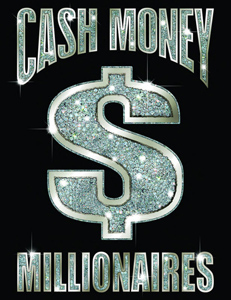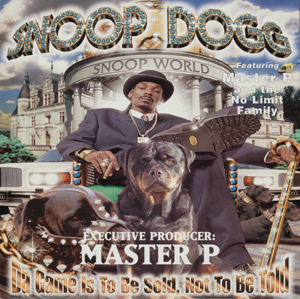
A small bit of history was made this past weekend in Philadelphia, as the final seconds ticked off the clock and our University of Houston Cougars celebrated a victory over the Temple University Owls in the inaugural game of the new American Athletic Conference.
The last few decades and, more recently, the last few years have sent fans of collegiate athletics scrambling to make sense of changing conference landscapes. The Houston Cougar football teams have a varied and winding history of conference affiliation that can be traced through many resources available here in Special Collections and via our Digital Library. A look through the Athletics Department Records in the University Archives or a virtual stroll through the old Houstonian yearbooks provide some perspective for an evolution that continues today and helps trace the history of collegiate athletic conferences in Texas, the Southwest, and beyond.
1946 – 1948 – Lone Star Conference:
The Houston Cougars football program was born in 1946, during a renaissance of collegiate athletics as an influx of veterans from World War II made their way onto campuses. At the University of Houston, the Veterans Village, housing veterans and their families, became a symbol of that new growth. These brand new Cougars played in the Lone Star Conference through 1948, competing against conference mates such as North Texas and Sam Houston State.
1949 – 1950 – Gulf Coast Conference:
After getting their feet wet in collegiate athletics, the University of Houston decided to branch out and helped form the short-lived, now-defunct Gulf Coast Conference alongside other charter members Midwestern State, Trinity University, and the aforementioned North Texas.
1951 – 1959 – Missouri Valley Conference:
The Gulf Coast Conference experiment did not last long for the Coogs and an invite to the Missouri Valley Conference was accepted where, starting in 1951, just five years after the team’s formation, the Cougars were already playing in their third conference. There they formed rivalries with Oklahoma State, University of Tulsa, and others.
1960 – 1975 – Major Independent:
Throughout these early years, flirtations persisted with the more prestigious Southeastern and Southwest Conferences, but these ultimately came to naught. After winning four Missouri Valley Conference titles in nine years of play, the Cougars struck out on their own again. This time they competed as a major independent football power from 1960 through the 1975 season, challenging and defeating some of the nation’s top programs and finding themselves nationally ranked, more often than not. Much of this success was due to the iconic, inventive, and legendary Bill Yeoman, head coach of the Cougars from 1962 to 1986. This new era of success did not go unnoticed by the in-state neighbors.
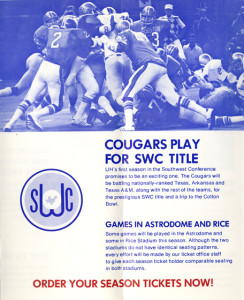
promotional material for the 1976 football season, from the Athletic Department Records, UH Special Collections
1976 – 1995 – Southwest Conference:
The long-awaited invitation from the Southwest Conference finally came for the 1976 season. The Cougars made up for lost time, besting the other major programs of the state (as well as the University of Arkansas), winning the SWC title three of the first four years in their new home, including the inaugural 1976 season that saw the Coogs finish with 10 wins, 2 losses, and ranked in the top 5 nationally. Conference affiliations and stability would be short-lived, however, as only two decades time would see the end of an era with the collapse of the conference in 1995, spurred on by the earlier loss of the University of Arkansas and the defection of the University of Texas, Texas A&M University, Texas Tech University, and Baylor University to the newly restructured Big XII Conference (note: For those further interested in studying the long-standing SWC institution, our colleagues at Texas Tech University continue to do a fine a job of making almost 100 years of intercollegiate athletic history available for study via the Southwest Athletic Conference Records).
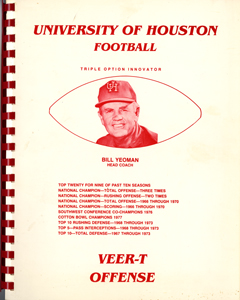
cover of Bill Yeoman’s Veer-T Playbook, available for viewing in the University of Houston Special Collections Reading Room
1996 – 2012 – Conference USA:
Again, the University of Houston forged their own path and became integral in the merger of the Metro and Great Midwest Conferences to form the new Conference USA where they would go on to compete against some new and old friends alike from 1996 through the 2012 season. It was during this era that the Cougars moved back onto campus, playing in a renovated Robertson Stadium.
The Present and the Future – American Athletic Conference:
Demolition has effaced “The Rob” from campus maps and new construction has fans and alumni optimistic for the future. A quick glance at the past or a look at the present headlines regarding collegiate athletics assures us that the only certainty is, nothing is certain.
Except this.
It is certain that autumn Saturdays will continue to see a handful of student-athletes fight for the red and white and dear old U of H.
And, it is certain, a remarkably diverse and unified nation of Cougar faithful will be there cheering them on in Philadelphia, Houston, and anywhere else the future takes them.
The growth of our Houston Hip Hop Collections continues with the recent publication of the Pen & Pixel Graphics, Inc. Records finding aid.
Bling!
Academics and “ballers” alike have heard the term and street cred is unnecessary to catch its meaning. It is what John Nova Lomax of the Houston Press described as a “false onomatopoeia… the sound a jewel or precious metal would make if it could be heard.” In 1992, as the twentieth century waned and the twenty-first century threatened to render the concept of “album art” obsolete, Shawn and Aaron Brauch founded Pen & Pixel Graphics, Inc. and went about helping to define the visual imagery that would become associated with so many hip hop artists from the Dirty South and beyond.
Bling-bling!
Labels like Rap-A-Lot, No Limit, and Cash Money Records came to rely on the Brauch brothers to create visually dense, hyper-stylized images of that “false onomatopoeia,” the monetary excess and conspicuous consumption contrasted against a reality of poverty, struggle, and reclamation. This imagery became the face of a new, emerging sound in hip hop. Given the pervasive influence of this visual style on an entire era of hip hop history, we are very excited to have this detailed finding aid now available to assist scholars in their research.
The Pen & Pixel Graphics, Inc. Records contain digital files, posters, t-shirts, and other promotional material for artists like Snoop Dogg, Geto Boys, DJ Screw, and others. Give the finding aid a look, indulge in the sampling recently published in our Digital Library, investigate some of our other collections, and come see us when you’re ready to take a closer look at some visual hip hop history.
